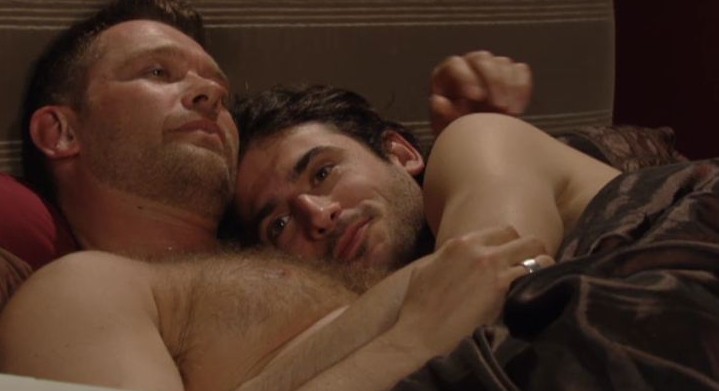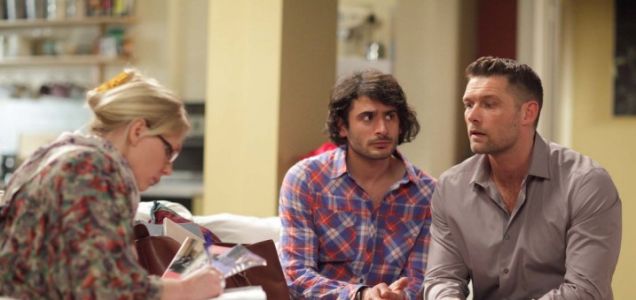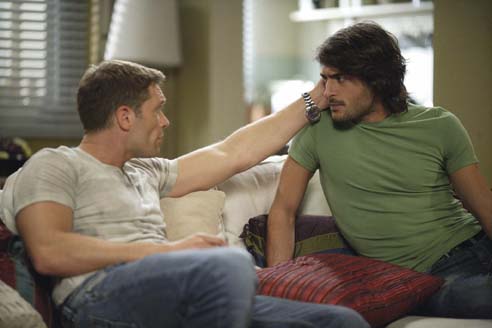Playing the Straight Field: Pre-Watershed UK TV and Gay Intimacy
Faye Davies / Birmingham City University

This week something happened that caught my attention. This was something that hadn’t seemed to have happened in the UK for a while, complaints about gay representation. The reason for this was the appearance of two gay men in bed together in the top BBC soap opera EastEnders. There were 125 complaints to the BBC over the scene, many claiming it would ‘confuse’ children at the UK pre-watershed time of 7.30pm; in the UK 125 complaints is noteworthy in regulatory terms.
The scene in question showed two gay male characters (Christian Clarke and Syed Massood) in bed together – naked from the waist up. The scene was certainly intimate but not sexual. The characters are actually long-term partners and were shown in each other’s arms in an intimate embrace. This is a couple who are planning their civil partnership and attempting to adopt a child. By any standards this storyline escapes the sexual ‘predatory gay’ discourse of yesteryear. But, the complaints certainly raise some questions about the nature of what intimacy between gay couples means to some UK audiences, especially when shown during primetime.
Whilst the characters involved in EastEnders are involved in a long term relationship – it seems that some of the national audience are still unforgiving when a scene more than hints that they may have had sex within the last hour, are close, committed and intimate. Why is this?
Is the playing field actually ‘straight’ when it comes to representing sexual preference, act, and commitment pre-watershed in the UK?

EastEnders appears to have overstepped the boundary of the non sexual gay man. Such characters as ‘Will’ and ‘Jack’ in Will & Grace are the predominant examples of such a non sexual discourse, hinting at their sexuality and sexual acts whilst virtually never actually realising this as part of the narrative. Gay sexuality has been increasingly represented in UK television soap opera since the 1980s and has informed a number of similarly stereotypical and oft seen character types and narratives. These characters can be sexual, but only if for the most part ‘they’ are single and any intimate act, visit to a gay area, or interaction with a wider group of gay people takes place off screen. This further highlights what appears to be a problematic issue with the particular construction of gayness on EastEnders; it can be considered ideologically rare and hegemonically challenging. I believe that these gay characters just weren’t enough of an ‘other’ in lifestyle terms for a number of reasons.
The unspoken pre-watershed ideological rules seem to be that gays are never to have sex or even hint at it; it’s a closeted issue. It is certainly suggestible that the major issue with the discourse present in EastEnders is that it is too close to the hetero-normative lifestyle. In turn it is possible to posit that the ideology of the gay lifestyle for some of the straight audience may not include romance, commitment, monogamous sex, a long term future or a family – all factors which are part of the current narrative between Christian and Massood.
This appears to be in opposition to the most visible, typified and overtly sexualised representations (post-watershed) such as Queer as Folk and Lip Service which have been shown with little complaint, albeit to much smaller audience than EastEnders commands. It appears that whilst gay culture and lifestyle can be represented diversely in what is labelled ‘gay drama’ this doesn’t seem to reach primetime soap. It seems that through scheduling and commissioning diverse representations of the gay lifestyle have only appeared when distinctly labelled as the ‘other’, and for the complaining 125 and others upset by EastEnders this has potentially become an acceptable norm.

Arguably this problem has occurred because the construction of reality in EastEnders is one where gay characters live, breathe, socialise, shop, fall in love, drink and die alongside the group the majority of the audience can relate to in terms of believability, credibility and verisimilitude, and this is hugely challenging in terms of dominant discourse. This isn’t a dramatic visit to the gay quarter of Manchester (Queer as Folk UK) or an insight into the lifestyle, relationships of and sexual acts of lesbians in Glasgow (Lip Service). Instead EastEnders is reminiscent of the audience’s own contextualisation of reality: their front door step, street, pub, bar, nightclub and community. This particular representation wasn’t ‘tailored’ for the heterosexual audience as the stereotypical ‘gay culture’ and neither did it encourage the non-sexual stereotype seen famously in Will & Grace. Perhaps Richard Dyer encapsulates this issue best when he states, ‘a major fact about being gay is that it doesn’t show…the person’s person alone does not show that he or she is gay,’ and whilst it was quite clear from the scene these characters were gay Dyer’s point is relevant because their actions, their interaction, and the narrative surrounding them was not.1 Arguably this settled gay relationship and the narrative context was a little too close to home to the normalised discourse of heterosexual society for some people to deal with.

In all this the BBC are to be commended, and I will let them have the final word of this column via their response to the complainants. Perhaps in the not too distant future more broadcasters will take the same stance and develop more rounded and diverse representations of gay relationships for screening pre-watershed and on prime time television. Hopefully this challenge to the norm will not seem as shocking to some in the long term future:
“EastEnders aims to reflect real life, and this means including and telling stories about characters from many different backgrounds, faiths, religions and sexualities.
We approach our portrayal of homosexual relationships in exactly the same way as we do heterosexual relationships, ensuring depictions of affection or sexuality between couples are suitable for pre-watershed viewing.
We would also point out that same-sex civil partnerships became law in December 2005, giving equal rights to gay couples in the UK. The BBC cannot discriminate by treating gay characters differently to heterosexual characters.”2
Image Credits:
1. EastEnders, Christian and Syed
2. Syed and Christian Inquire About Adoption
3. Christian and Syed
4. Christian and Syed Making Their Bed
Please feel free to comment.
Great article Faye. There are a couple of things that I find intriguing about this piece (and the discourse of televisual gay representation generally). First, the BBC appeared very progressive in its defense of the scene as being well within the rubric of societal norms. While 125 complaints seem like a relatively small number, perhaps this could have been outweighed by viewers showing their support. At least in the US, there seems to be an overarching passivity whereby one only writes a letter if one is angry, not when one is pleased.
Second, in Will & Grace and other network, primetime US-based shows that feature gay representations, it seems that there is are two archetypes that work within the discourse – the sexless single man and the sexless gay couple all in a bid to receive some semblance of respectability by a mainstream(read: heterosexual) viewership. Scenes like this rarely occur on American network television and are relatively tame particularly if one compares it to heterosexual sexual expressions on a show like Sex and the City.
But there is another question to be raised here: was the “outrage” rooted in the notion that two men in bed are “gross” while two women in bed are “hot”?
The othering of gays continues. Protests against legal gay marriage, depictions of gay sexuality in media, and limited “tolerance” of gay people in public life predominate in the United States. And, based on the protests generated by the EastEnders episode, this persistent Gay as Other (lesser) People ideology endures in the UK as well. Earlier this week, a large Gay Pride celebration disrupted my normal bus route. The route went through the center of the festivities, and many participants rode this route to and from the parade. The vicious anti-Gay commentary I heard from bus riders shocked and saddened me, but the proudly gay riders maintained their dignity in the face of brutal verbal abuse. The fact that the abusers were African Americans–and so were the majority of the LGBT festival goers–simply made the situation worse.
It’s actually none of our business what Gay people do–whether they get married, cross-dress, have partners of the same sex (or gender), or cuddle together in bed. What is inexplicable is that anyone would get angry or object to behavior that is completely ordinary in a heteronormative context.
Oh well. The best thing I saw, on my bus ride home, was a grandmother and her little grandson riding home from the festival. The child had ribbons, pinwheels, a sticky face, and other signs of “great day at the park with Grandma!” Grandmother and grandson had just enjoyed a beautiful day in the park at the festival, enjoying free pinwheels, tote bags, stickers and balloons that one gets at any festival. This graceful senior citizen and her adorable grandchild simply didn’t care that their great day at the park was the St. Louis Gay Pride Fest. That was none of their business or concern. Why should being gay concern them, or any of us?
Thank you for this insightful piece, though I can’t say that I’m in any way surprised by the viewer outcry. Perhaps what is most disturbing to straights who object to gay representation that is arguably heteronormative, is that the “normative” hardly bears scrutiny. Being asked to question what is “normal” is perhaps a bit too challenging for some as such questions skewer the presumptions embedded in the indoctrinal practices of culture? On the other hand, the queer critique of gays who strive to be heteronormative falls within the same skepticism regarding normalcy. Normalcy cuts both ways.
Wow! Bravo BBC! This article, at least for me, is hopeful and difficult and fascinating and frustrating. I agree with Michael above. “Normalcy cuts both ways.” This show (I haven’t seen it) sounds like what many have been waiting for. Representations long overdue and yet… are they too gay for the “straights” and too straight for the “gays”? Whatever the answer, “more please!” Normative is socially constructed. I think/hope this is an instance where if we see it enough, we’ll “get used to it,” and that wouldn’t be a bad thing.
Thanks for the comments all – I think much of the analysis around gay representation seems to conclude there is no ‘perfect’ ground. There can’t be perfect ground as there is no ideal gay man or lesbian. BUT I think what this case study shows is that representations of gay culture are starting to embrace the everyday rather than the gay stereotype – however difficult these narratives may be for mainstream audiences to consume. It’s nice to see the BBC stepping outside of the ‘gay drama’ box to a greater extent than before, although there have been other gay representations in EastEnders in the past.
Summiyah – Hi there, it would be great if you could expand a little more on your point.
Pingback: Playing the Straight Field: Pre-Watershed UK TV and Gay Intimacy « wildewire
To complicate the “progressive/regressive” dichotomy even more, I would argue that shows like WILL & GRACE were so popular, because straight audiences “mentally prepared” themselves for the possibility of seeing something “sexually disturbing” like two men in bed. And that that was part of the exhilaration.
When one goes to a zoo, and one sees a lion, beautiful as ever, safely enclosed behind a cage, one can enjoy the experience because there is no imminent danger. But when one walks in the door from a hard day’s work and sees the lion lounging in the La-z-y Boy, the shock factor is intense, unexpected, and unappreciated. I seriously just came up with that metaphor and I love it.
So I believe this particular phenomenon – the location (mental or otherwise) of the audience – also has to be considered when discussing what is “good” gay representation. Something like GLEE can show two men making out and call itself groundbreaking compared to a show devoid of gay characters that has a teeny-tiny intimate scene (which outrages its audience) and also be quite groundbreaking. It will be interesting to see how the audience reacts to this relationship going forward.
Well done BBC lets hope the soaps continue to show gay people for who they are and break the stereotypes!
Eastenders portrays life so why cant people just accept the fact that 1 its a Tv prog trying to show all walks of life 2 that gays are a part of that life and 3 they have a life.there are too many more important things to worry about,children know far more than we did at a young age and get on with it they dont need to be coddled, they are well informed and take it in there stride,the older generation have the problem with gays as they were not educated to the standard our young ones are. Why cant people accept that it is a fact of life that we have gay people on our planet and they should have the same rights as us,(what makes US so special)They are gay, not pedafiles,not rapists, murderers,wife beaters, they are people who were unlucky when genes were dished out. Had my son been born gay i would have loved him more,if that were possible , because of the small minded people he would have come up against.let people live their lives in peace its too short to deprive anyone of happiness and if a tv prog can help the minority get a better footing and make life better for them then go for it Eastenders your doing a good job. Im 65, never had a problem with peoples sexuality